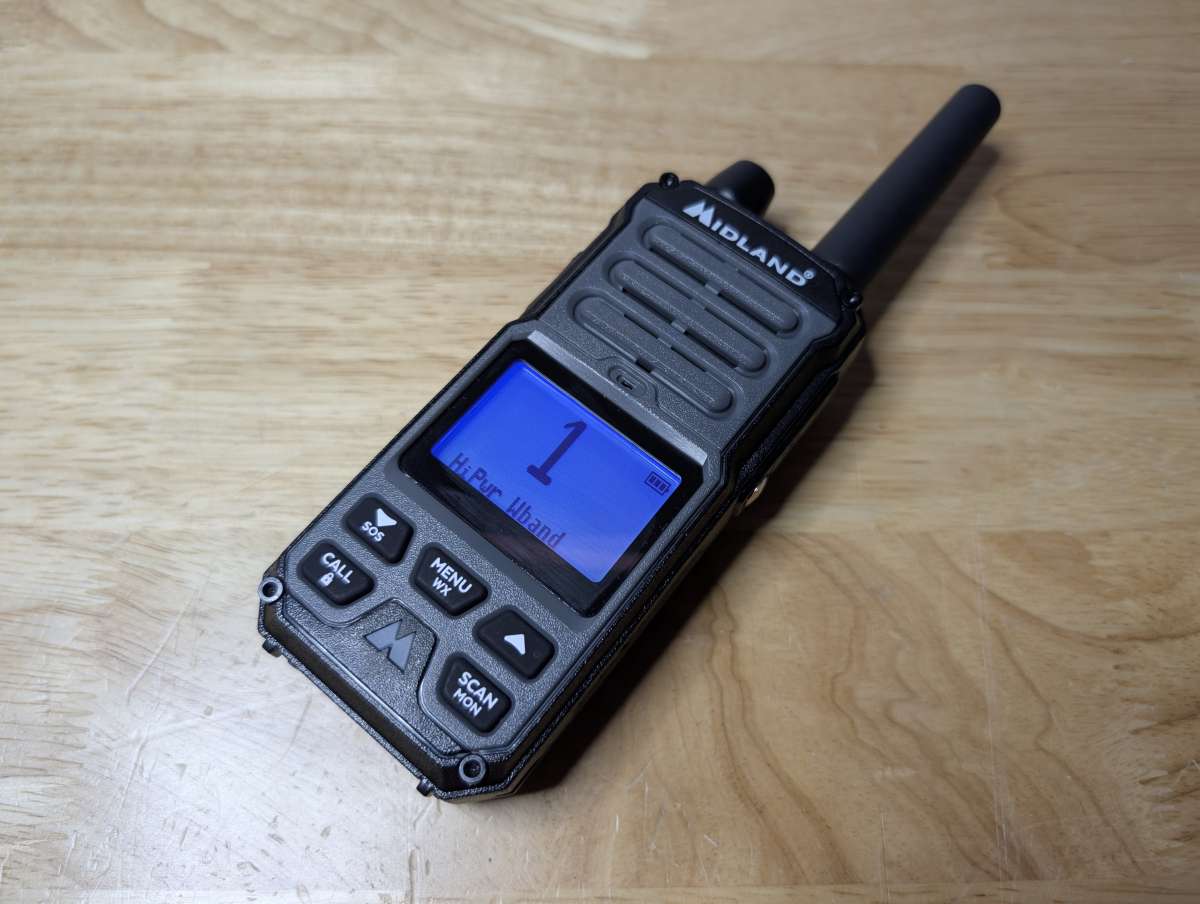
REVIEW – I’ve been a fan of Midland products since my dad first let me talk on the CB radio he had in his 1966 Volkswagen Beetle. I felt like I was a character in Smokey and the Bandit, asking truckers on the highway for a “radio check.” The thrill of handheld communication has stayed with me all these years, and luckily, Midland is still putting out innovative products.
I recently was able to try out the Midland GXT67 Pro GMRS 5-Watt two-way radio and enjoyed using it so much, I felt like that little kid again. The GXT67 Pro is a great addition to Midland’s line of GMRS radios, and I’m excited to test it out with the Midland MXT500 MicroMobile radio I reviewed back in July 2022. Priced at $199.99, the GXT67 Pro is expensive for a handheld, but worth it when considering its great design and included accessories.
⬇︎ Jump to summary (pros/cons)
Price: $199.99
Where to buy: Midland and Amazon
What is it?
The Midland GXT67 Pro is a 5-Watt General Mobile Radio Service (GMRS) two-way radio that features 22 channels, a 50-mile range, weather alerts, and IP67 water-resistant construction. With its simple, functional design, the GXT67 Pro is geared toward users new to GMRS radios, directly competing with the cheaper, more popular Baofeng radios.
Take note that radios like the GXT67, which operate on GMRS frequencies, require an FCC license. You must be licensed prior to operating the radio. You can apply for a license at the FCC’s website, as I did.
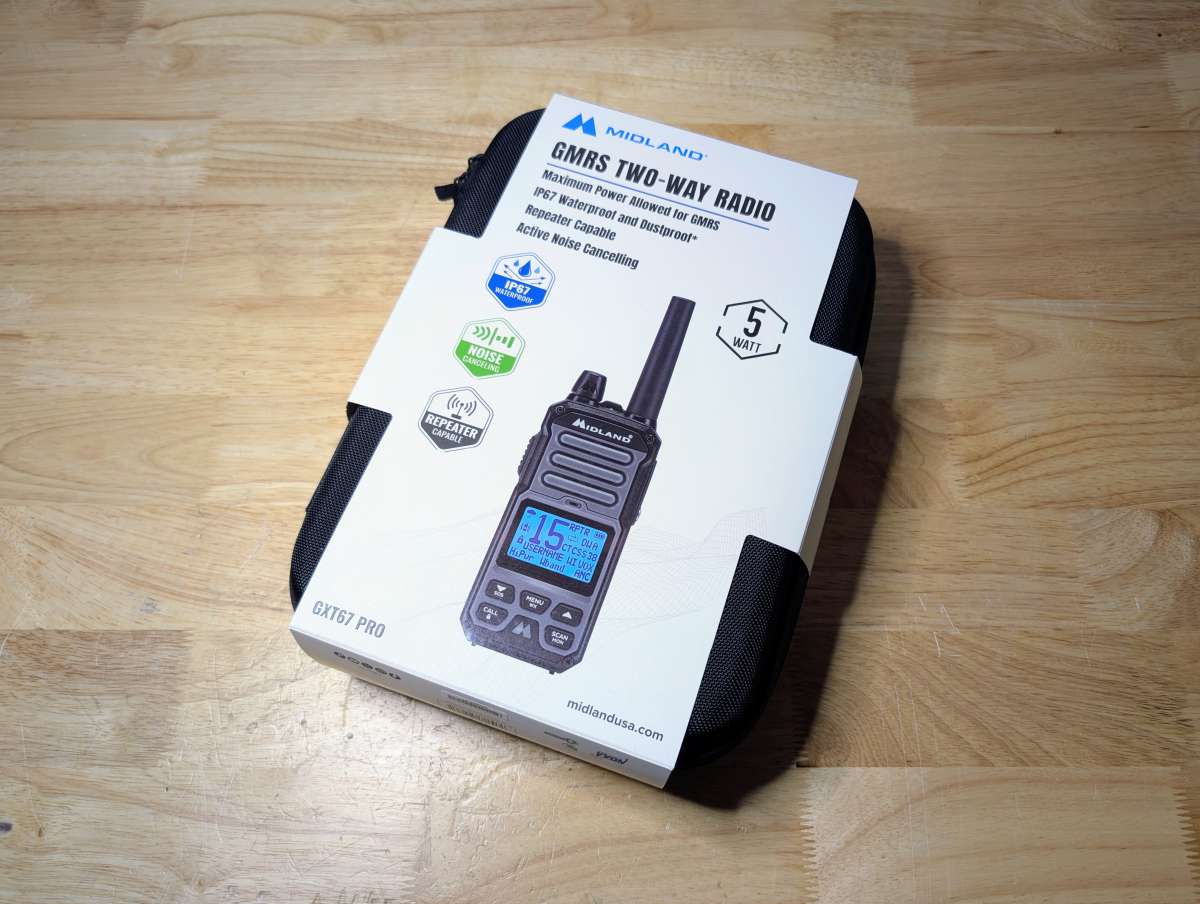
What’s included?
- Midland GXT67 Pro GMRS 5-Watt Two-Way Radio
- Belt clip
- Desktop charger
- AC wall adapter
- USB-C charging cable
- Snap-on DC vehicle charger
- Owner’s manual and quick-start guide
- Carrying case
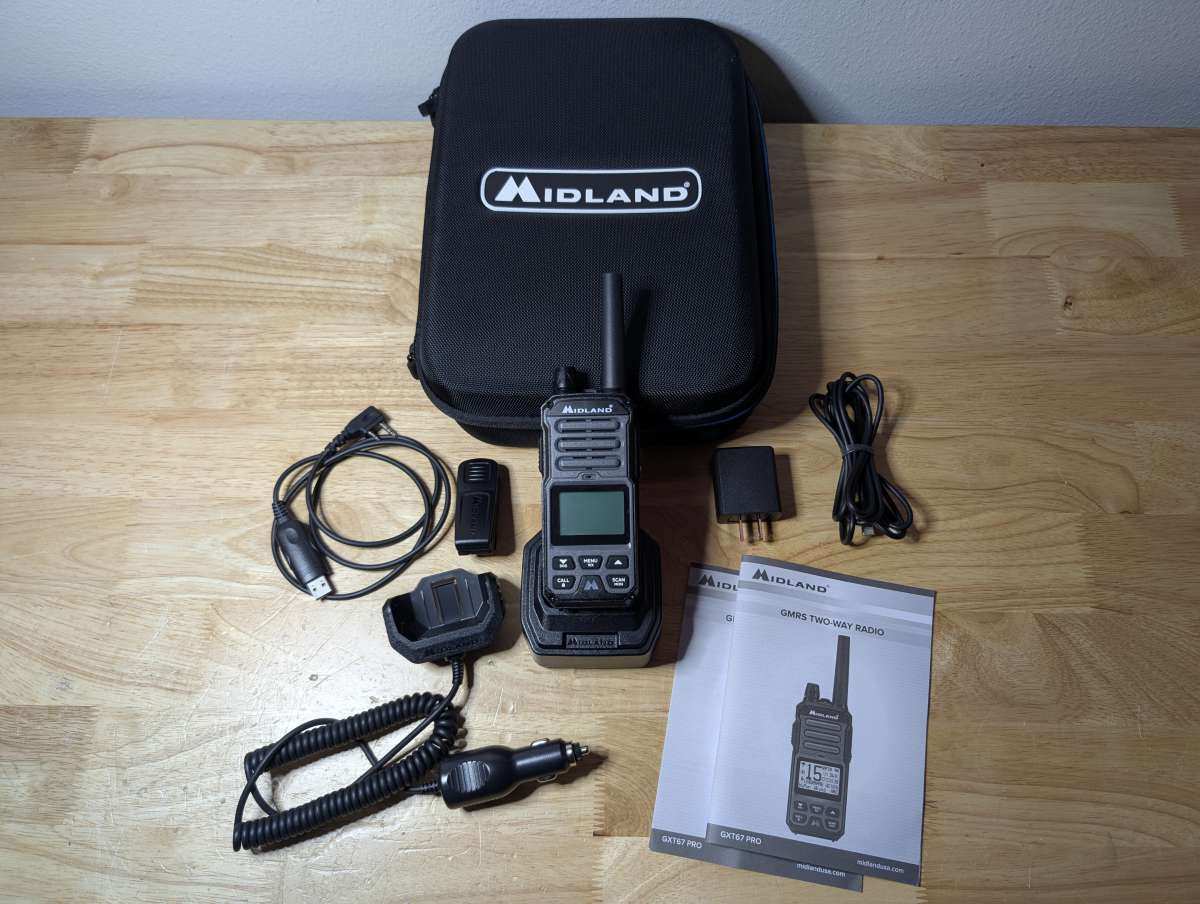
Tech specs
- 22 GMRS Channels + 142 Privacy Codes
- 28 Midland Preset Channels
- 8 Repeater Channels
- “Split tone” capable for repeaters that have a different privacy code for input and output
- 10 NOAA Weather (WX) Band Channels
- 38 CTCSS (Continuous Tone-Coded Squelch System)
- 104 DCS (Digital Coded Squelch)
- 10 groups, 143 group codes
- Microphone Automatic Noise Canceling (ANC)
- 16-hour battery life based on average operating cycle
- Operating Frequency: UHF 462.5500 ~ 467.7125 MHz
- Power Source: 7.4V 2500mAh Li-Ion Battery
- USB-C and 12VDC socket recharging
- IP67 waterproof and dustproof
- VOX hands free
- Group and direct call
- 10 selectable call alert tones
- Vibrate alert and whisper talk
- SOS siren
- High / Medium / Low TX Power Settings
- Selected channel scan and Dual Watch Pro
- Backlight off or 5 brightness levels plus, 7 backlight colors
- Battery Level Meter with Low Battery Indicator
- Narrow and wide band operation
- Silent operation, keypad lock, monitor and roger beep
- Dimensions: 1.5″D x 2.2″W x 4.9″H
- Weight: 9.6 ounces
Design and features
The Midland GXT67 Pro radio has a simple, ergonomic design that looks great and feels comfortable to hold. One design element I really like is locating the screen below the speaker, which makes so much sense. This way, when in use, your face isn’t pushed against the screen, and the mic lines up better.
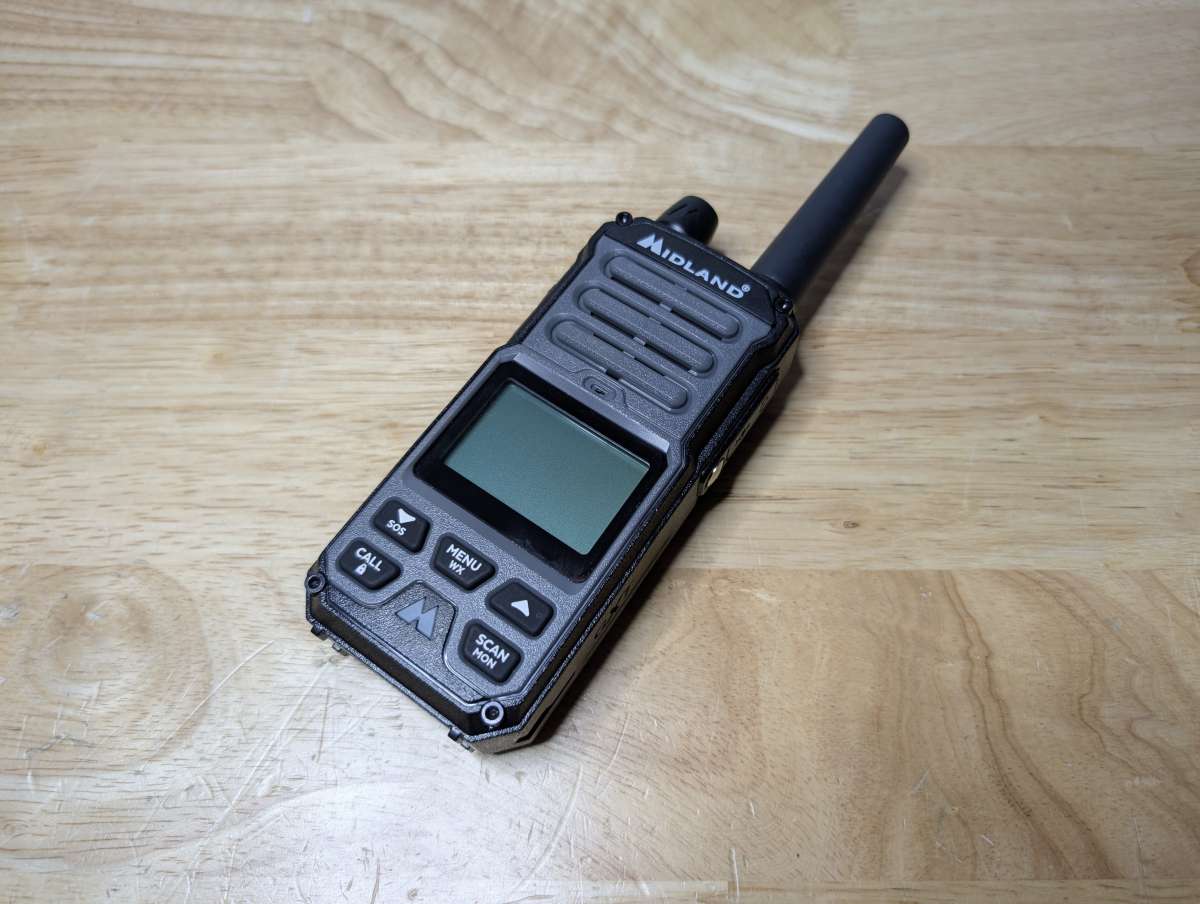
The body of the GXT67 Pro is made of two-tone textured ABS plastic. The texture helps with grip in wet weather, and the oversized ridges protect the device from fall damage. The LED screen is clear and easy to read with a backlight that can be turned off or used with five varying levels of brightness plus seven different colors.
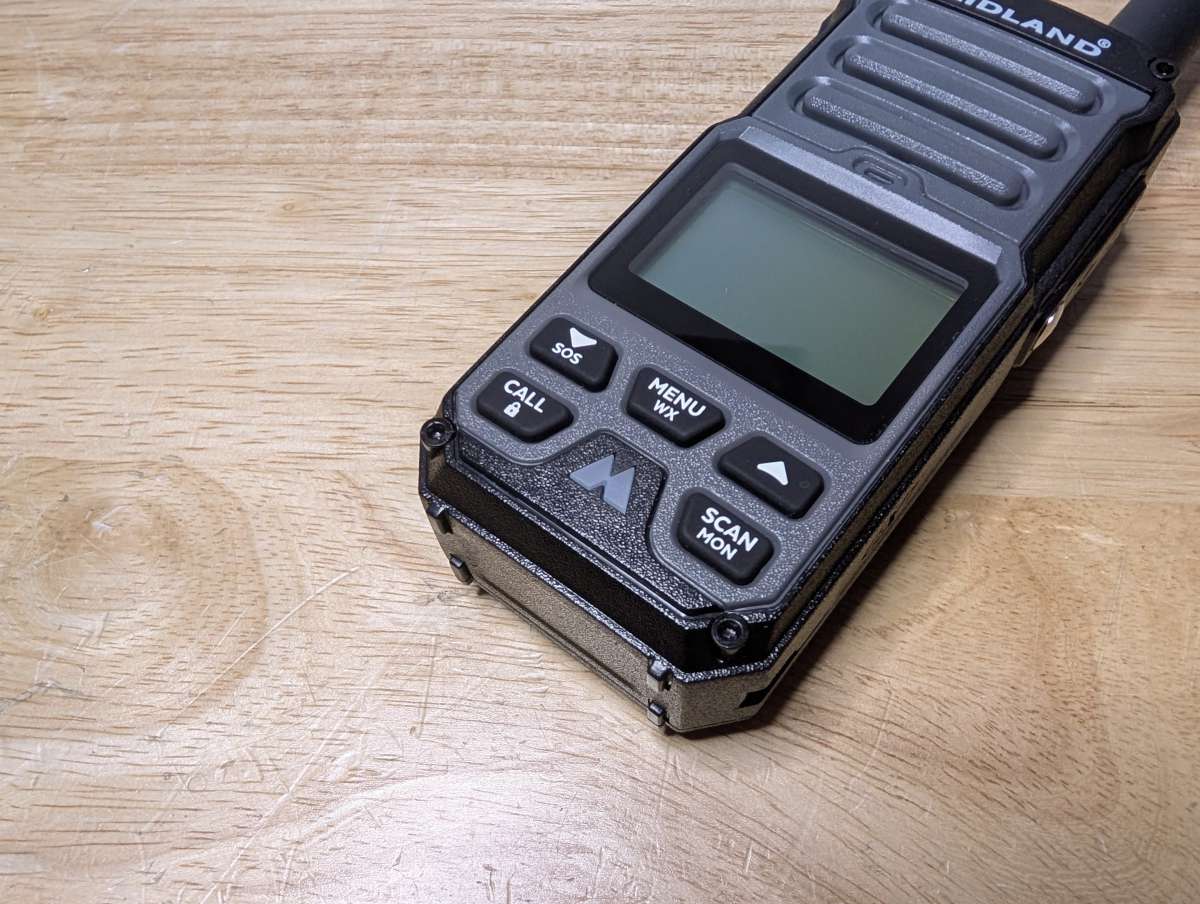
The large rubber buttons on the face of the GXT67 are intuitively placed, clearly marked, and have a great clicky feel to them.
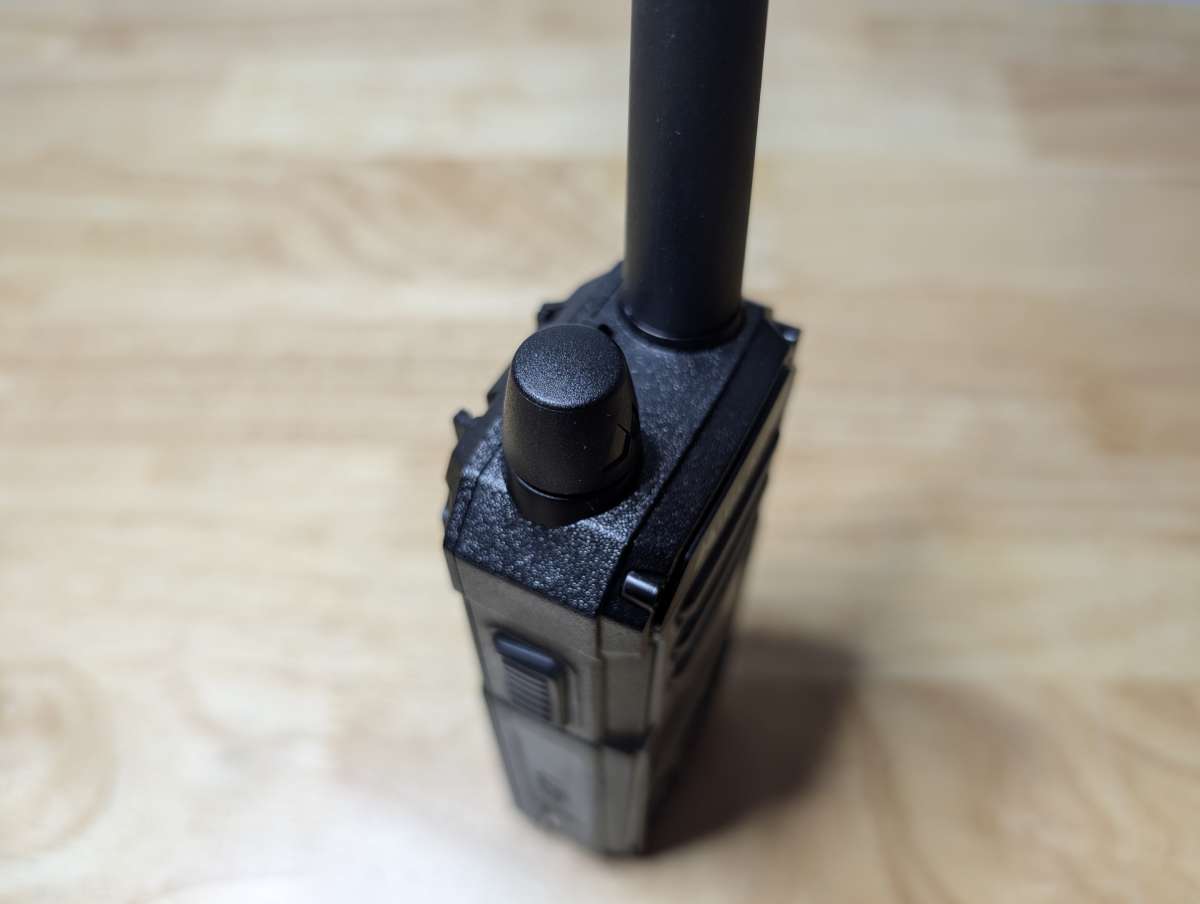
The top of the Midland GXT67 radio has a large knob for powering on the radio and controlling the volume. The thick antenna of the GXT67 Pro is also on top and notably not removable.
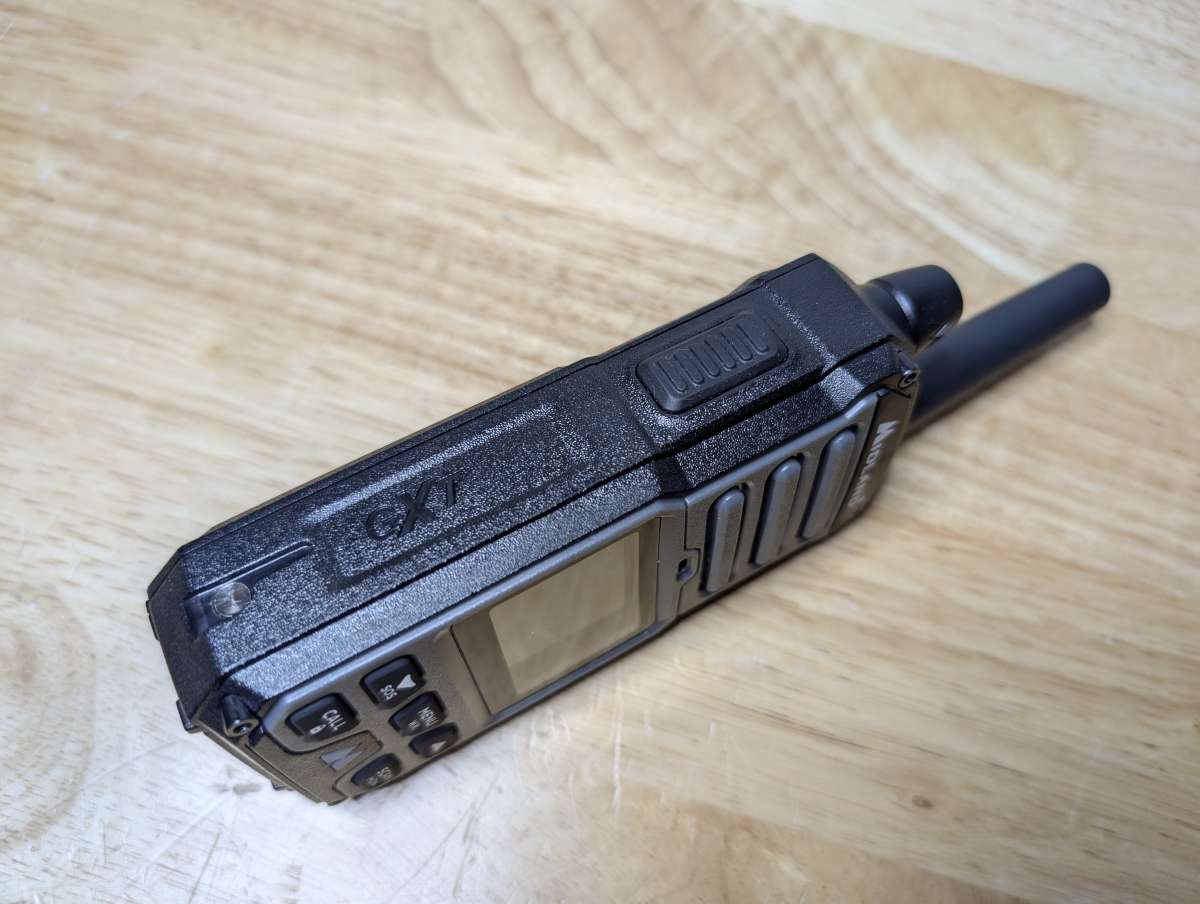
One side of the GXT67 Pro has the transmit button, also known as the Push-to-Talk (PTT) button, which is also heavily textured rubber.
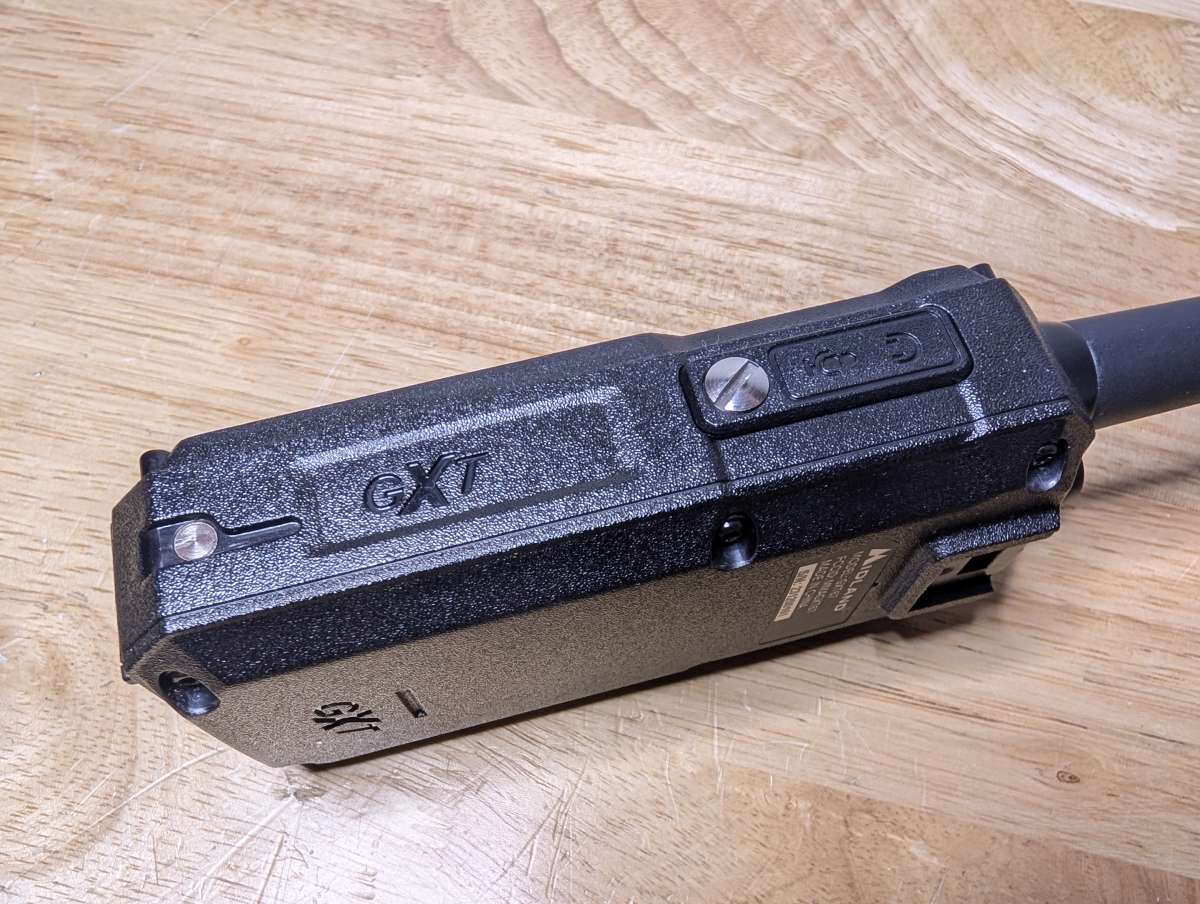
The other side of the GXT67 houses the external mic and headphone ports.
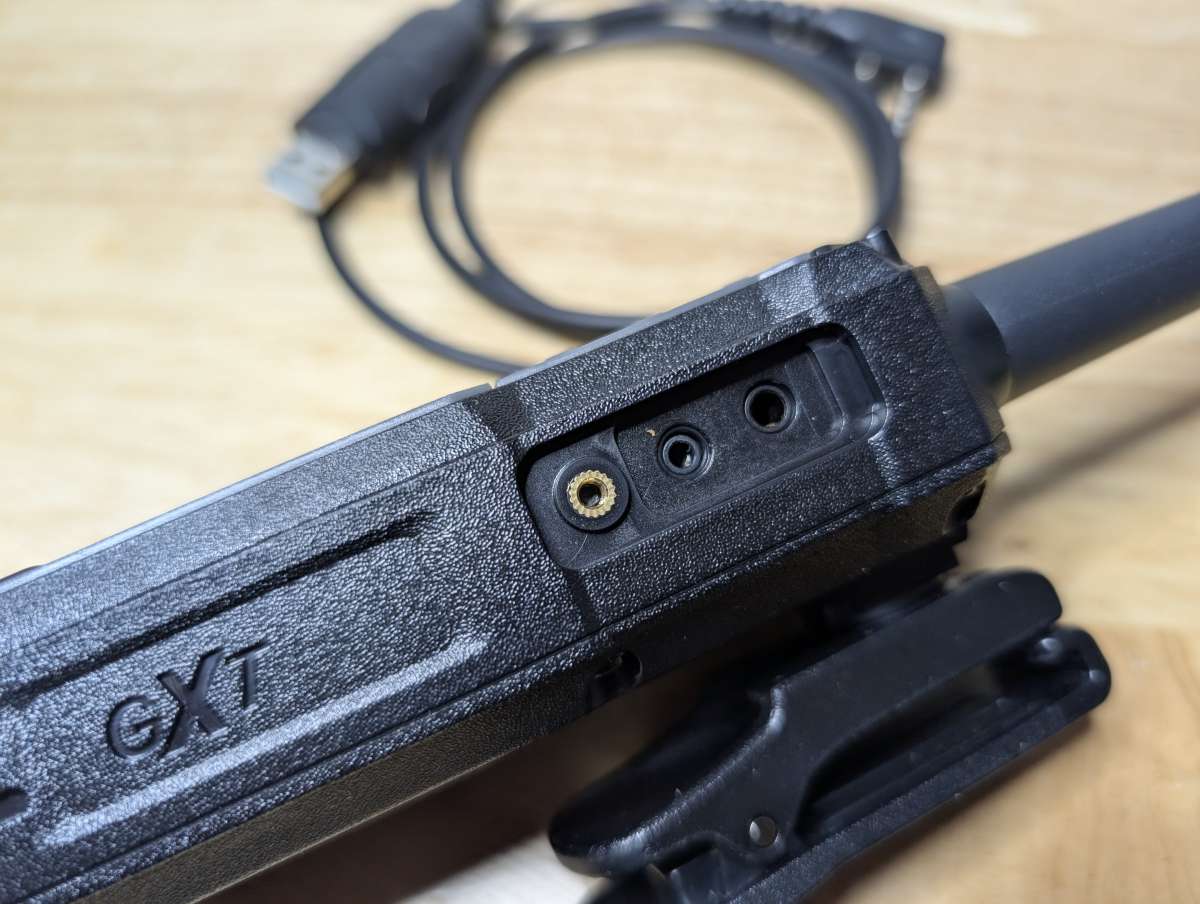
To maintain the IP67 rating, the ports are protected by a small tab that’s removable via a flathead screw.
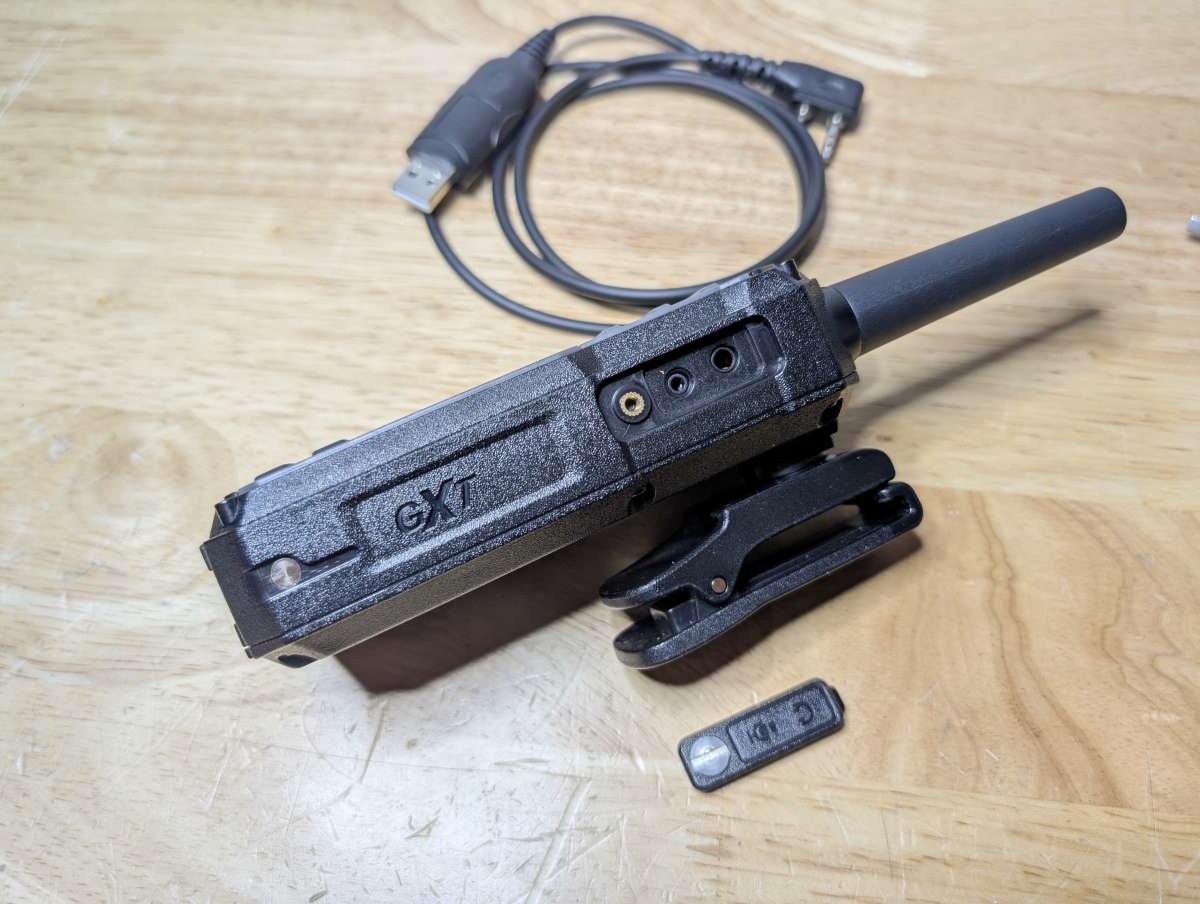
I like that the ports are well protected, but I do wish the tab stayed connected to the radio to prevent it from being lost.
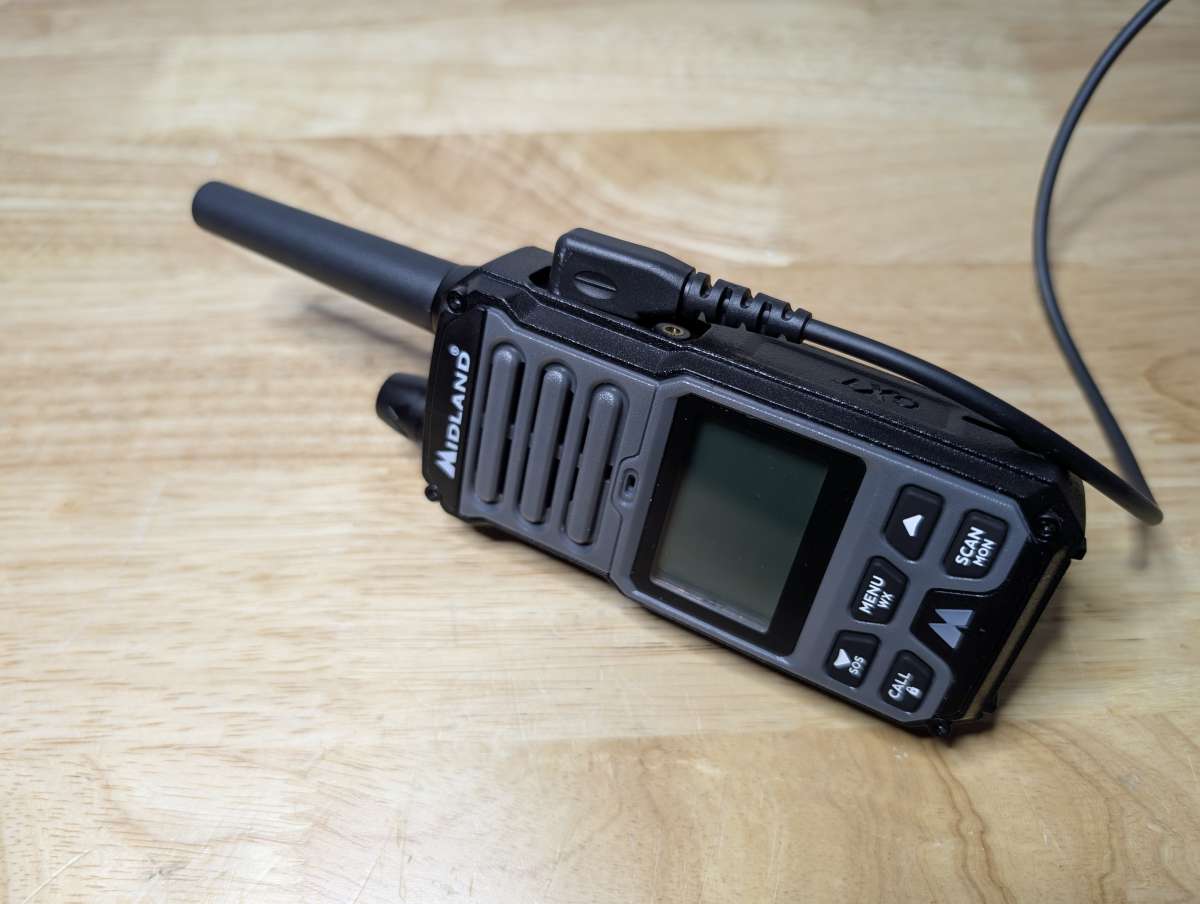
The mic and headphone port are also used to connect the GXT67 to a computer for programming using the Midland GXT67 Pro Programming Cable, which is sold separately.
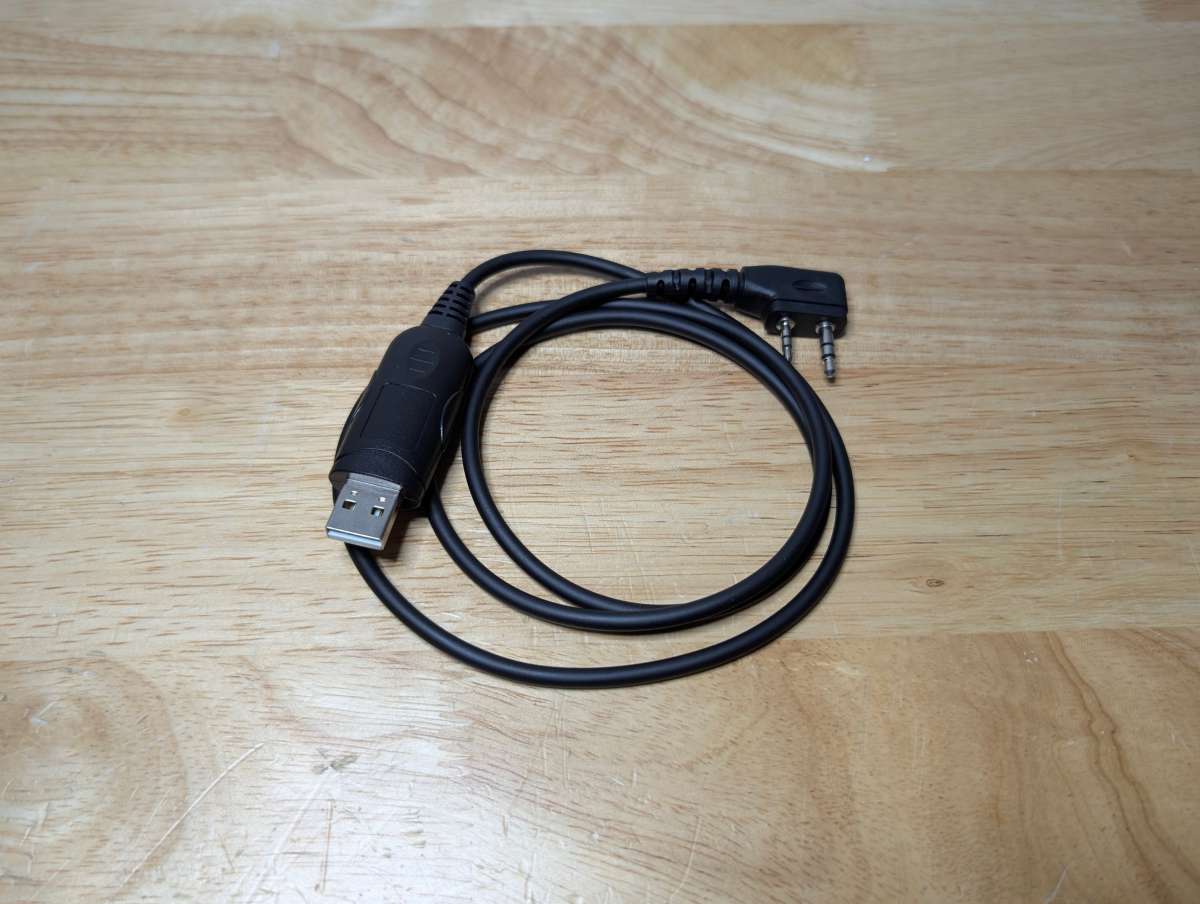
Using the programming cable, a PC, and the Midland GXT67 software allows you to access features that the radio menu interface cannot provide. These features include saving and reloading configurations, defining up to 49 custom channels, and assigning custom names to channels with up to 8 letters or numbers. This makes managing the radio’s settings a little easier and is much more user-friendly.
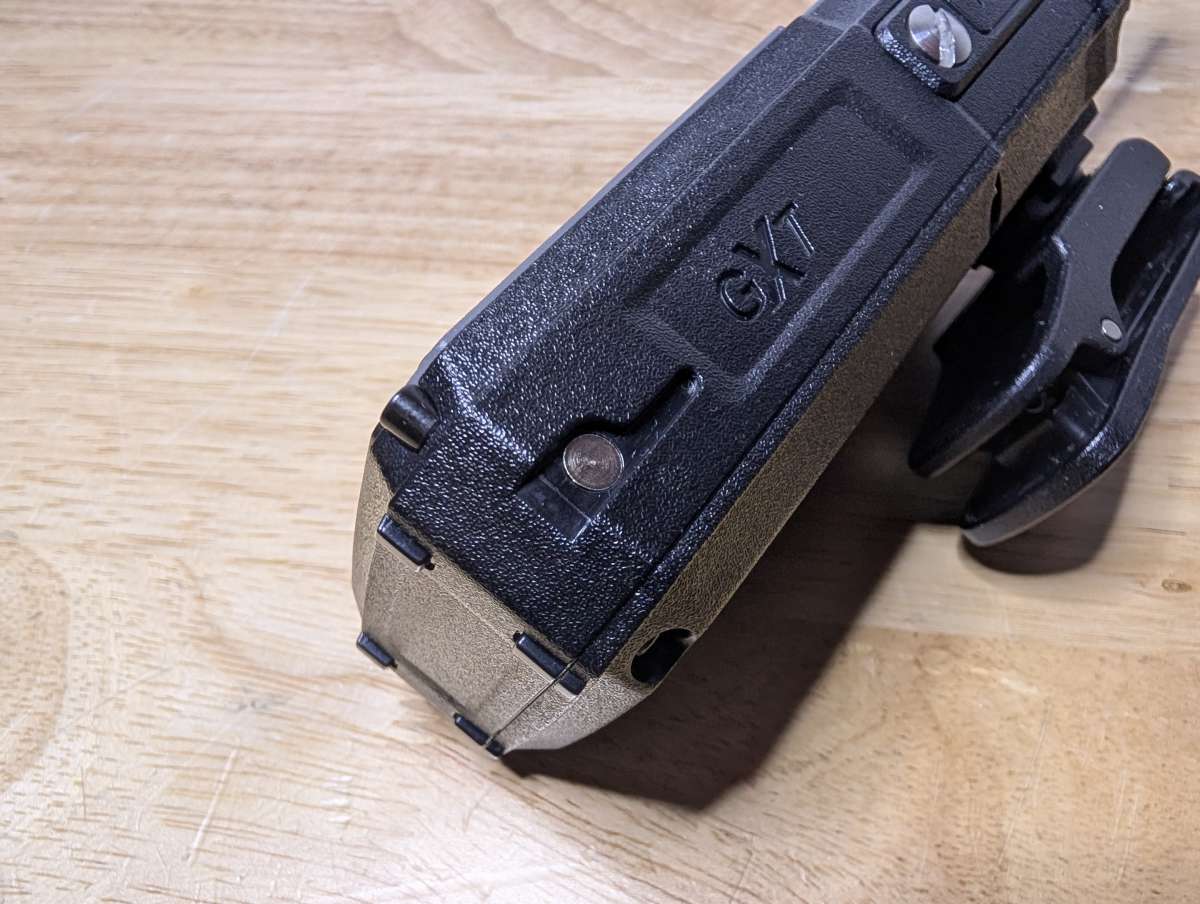
There are contacts on the bottom of both sides for the charging docks to connect to the GXT67. Notice the deep groove the charging contact sits inside, ensuring a solid connection with the docks.
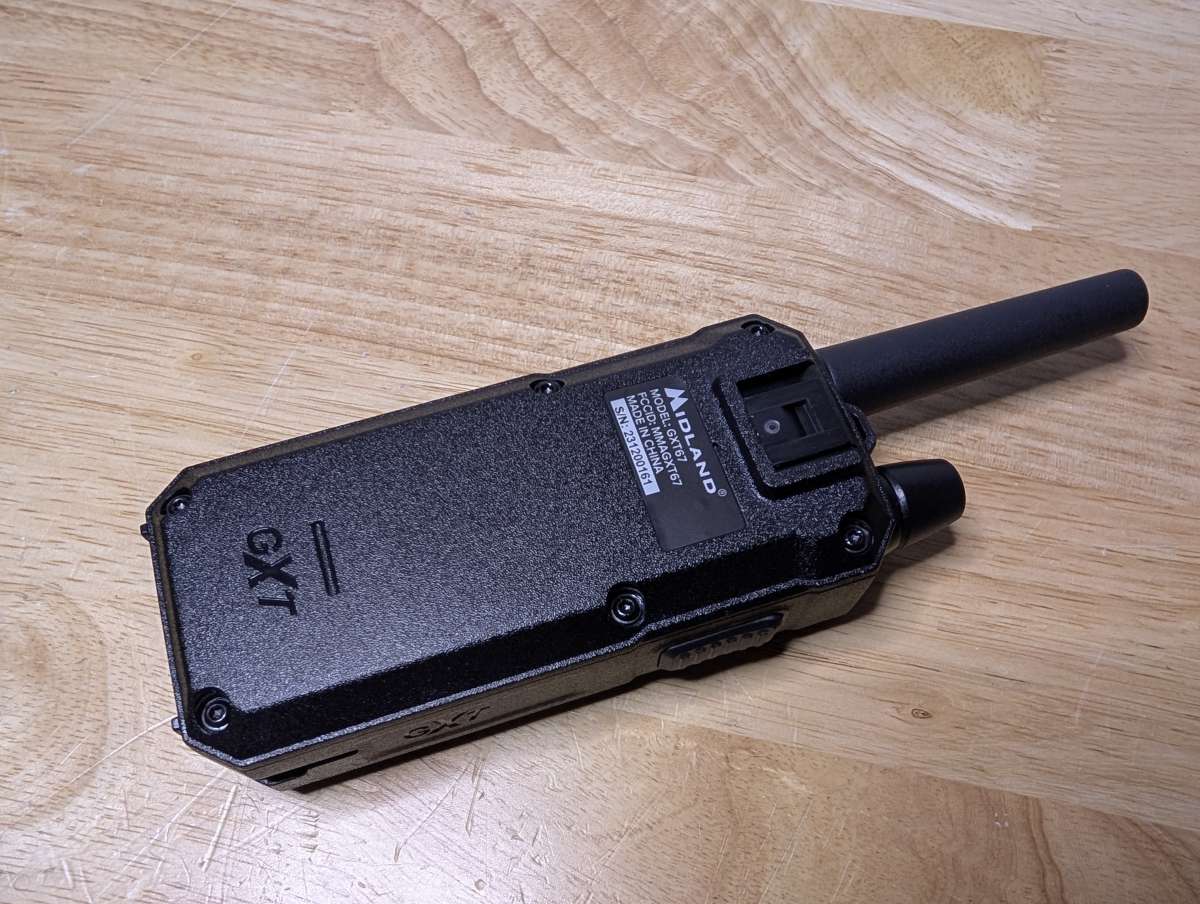
The back of the GXT67 is bare except for the serial number plate and the slot for mounting the included belt clip.
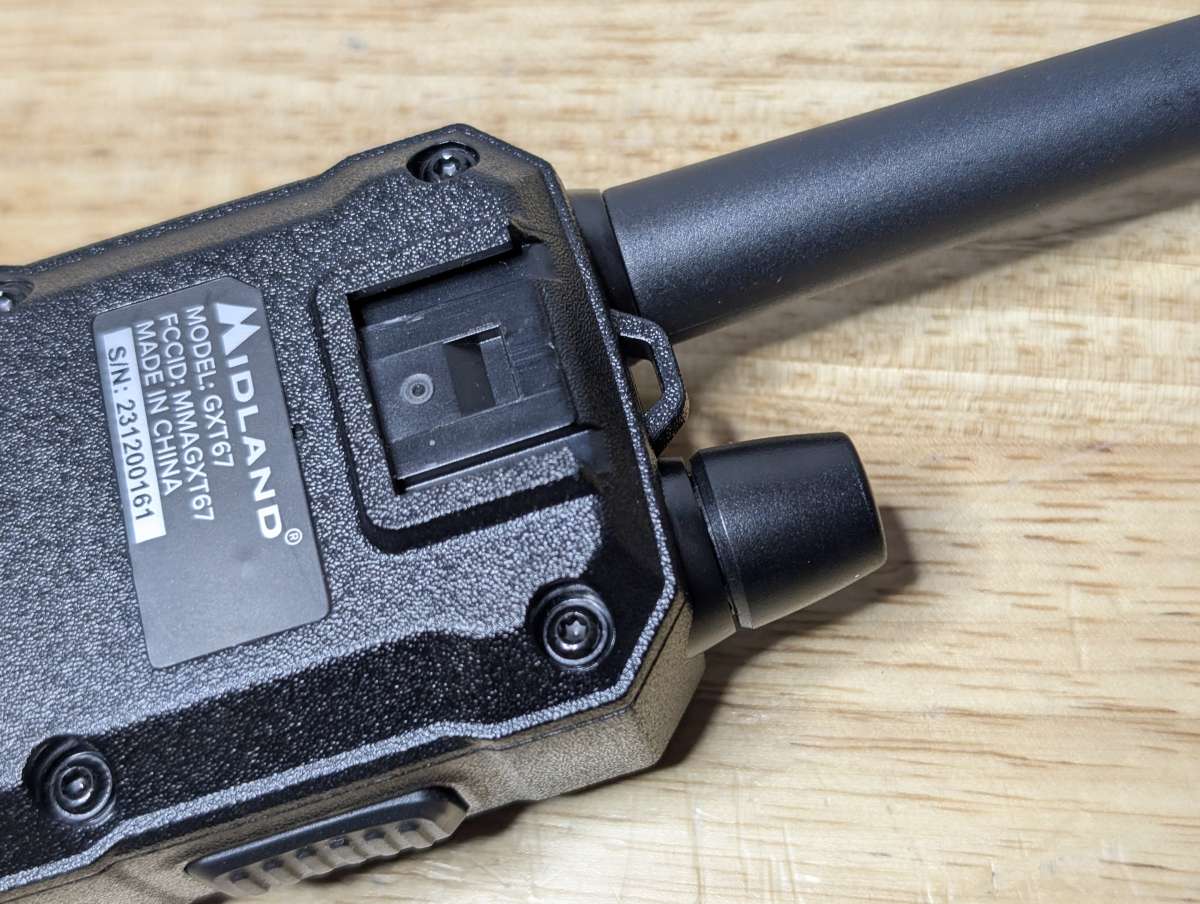
Just above the belt clip slot is a small loop to connect a lanyard.
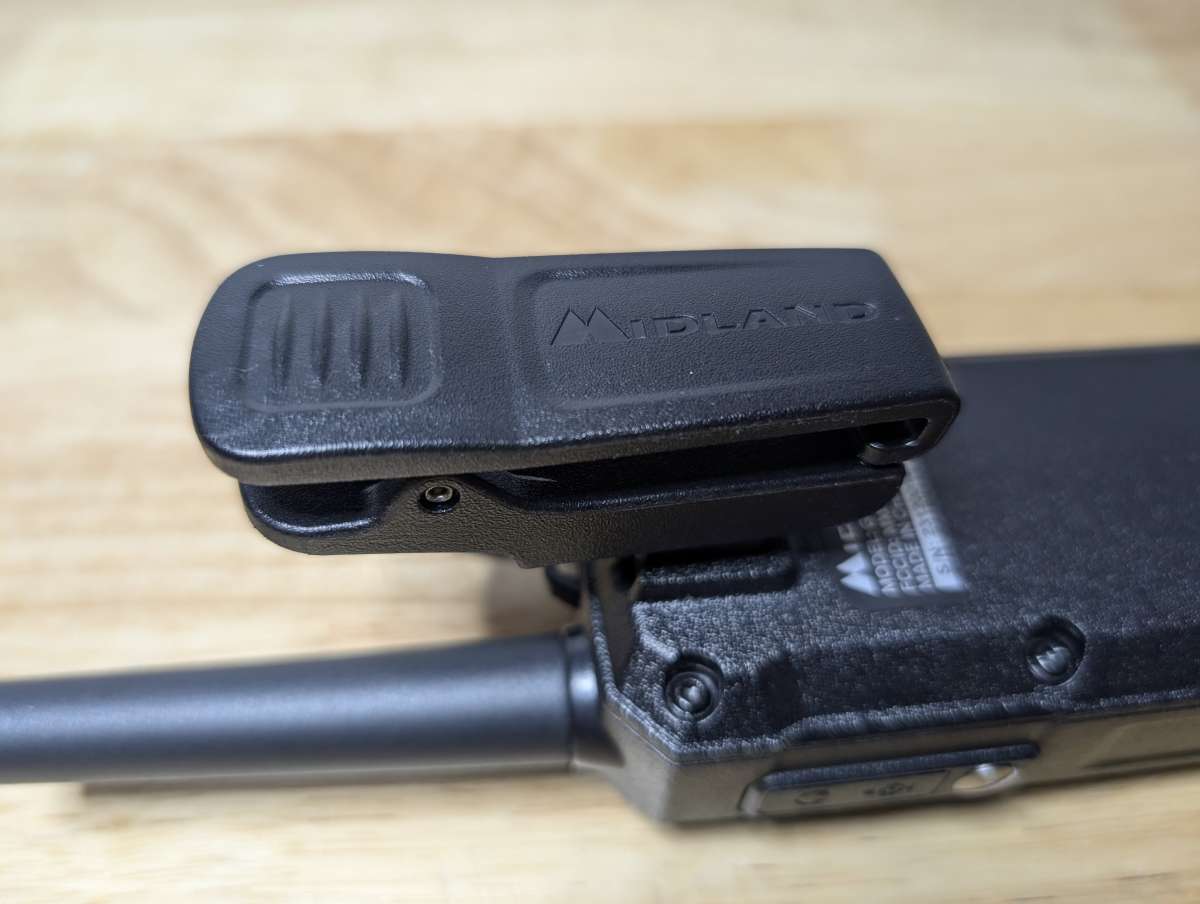
The included belt clip snaps into place easily and is rotatable, so you can carry the GXT67 in a few different positions.
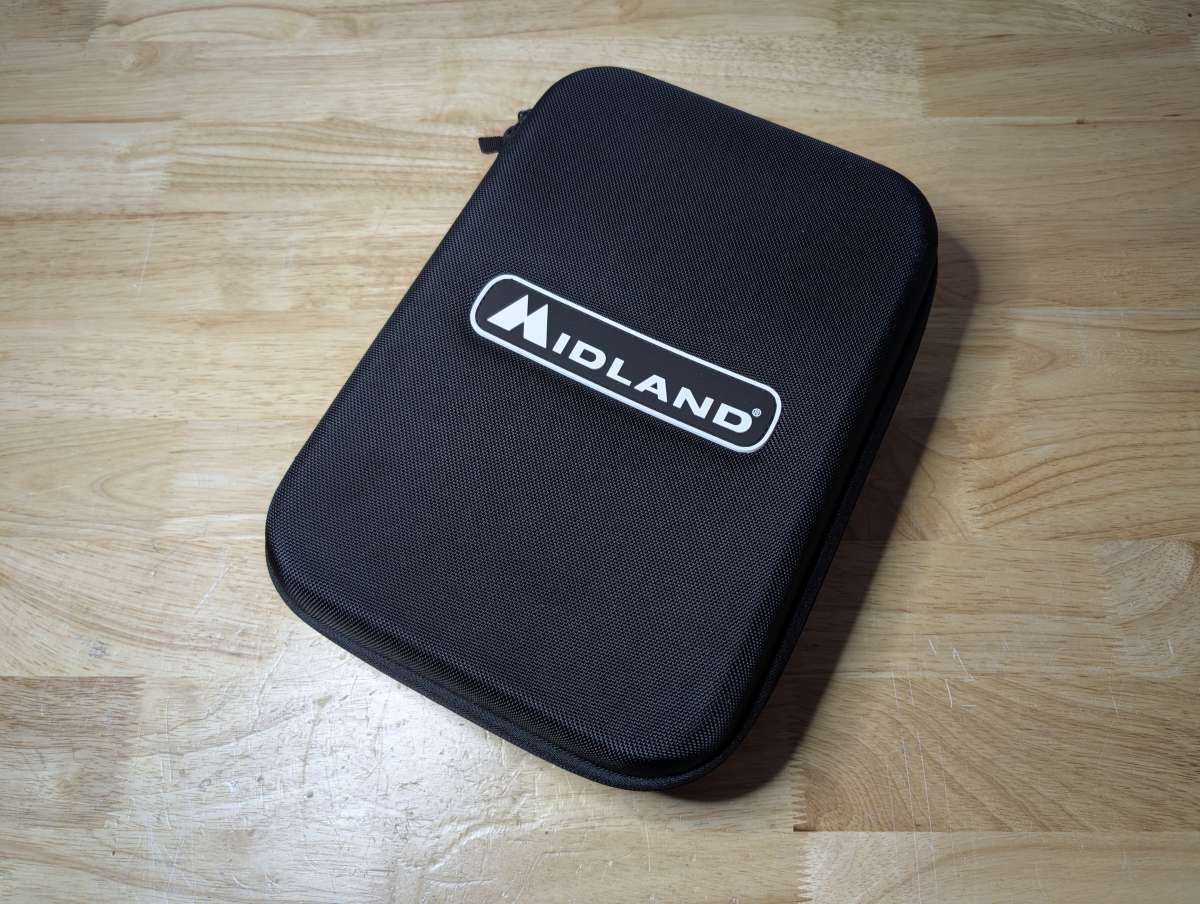
One of the best features of the GXT67 is the carrying case. This case zips closed and holds the GXT67 Pro plus all of its accessories with plenty of room to spare.
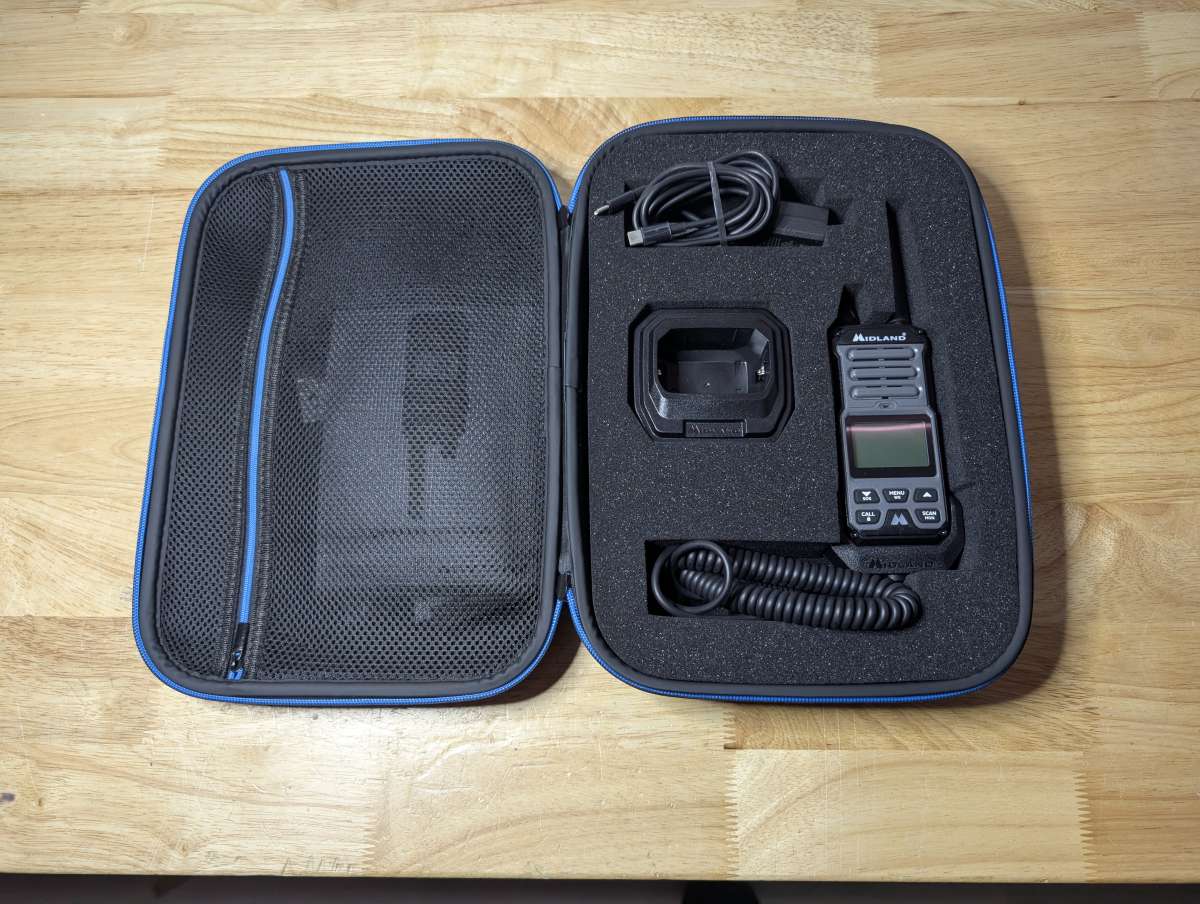
Everything is safely secured in foam cutouts, and there’s a separate zippered interior for small items.
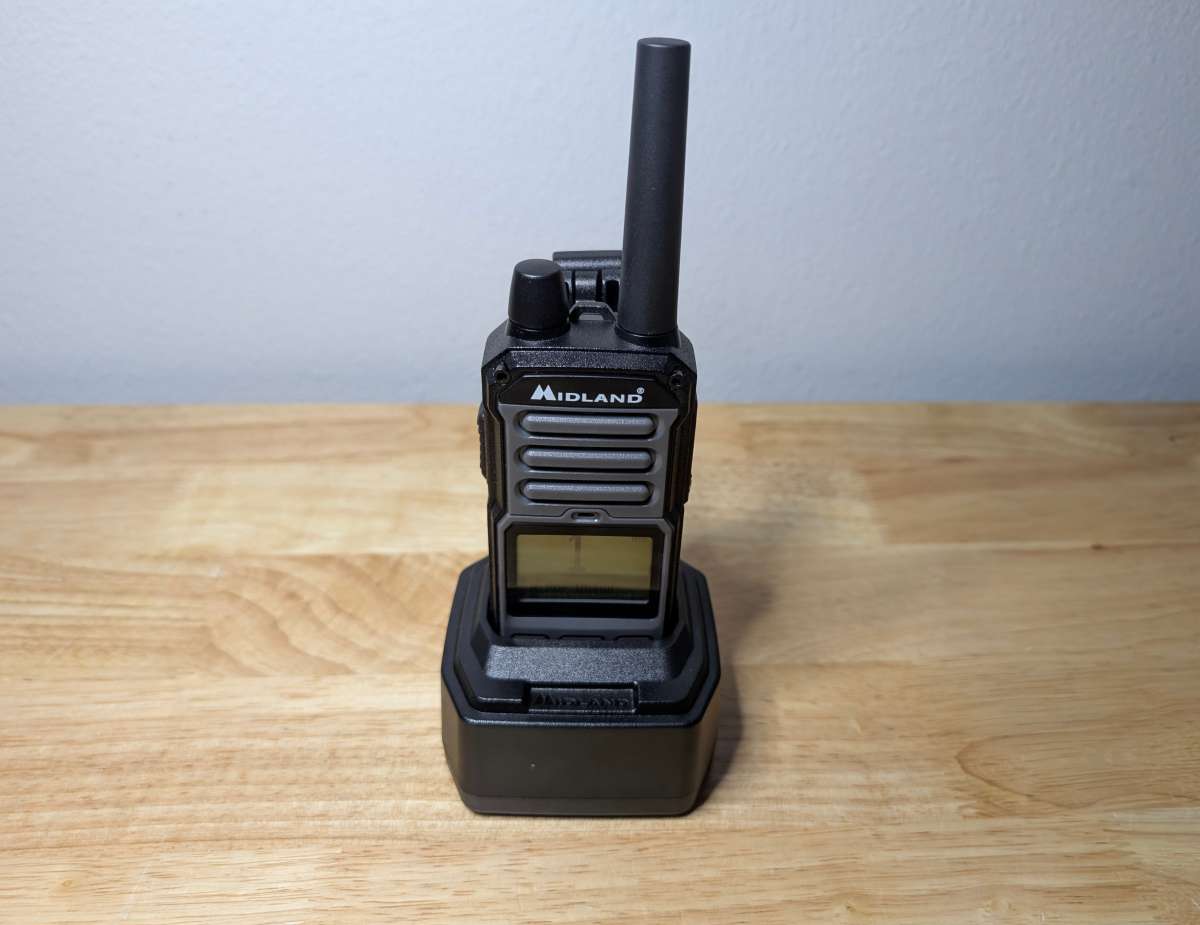
The GXT67 Pro has a rechargeable internal battery that can be charged using the included desktop dock or car charger.
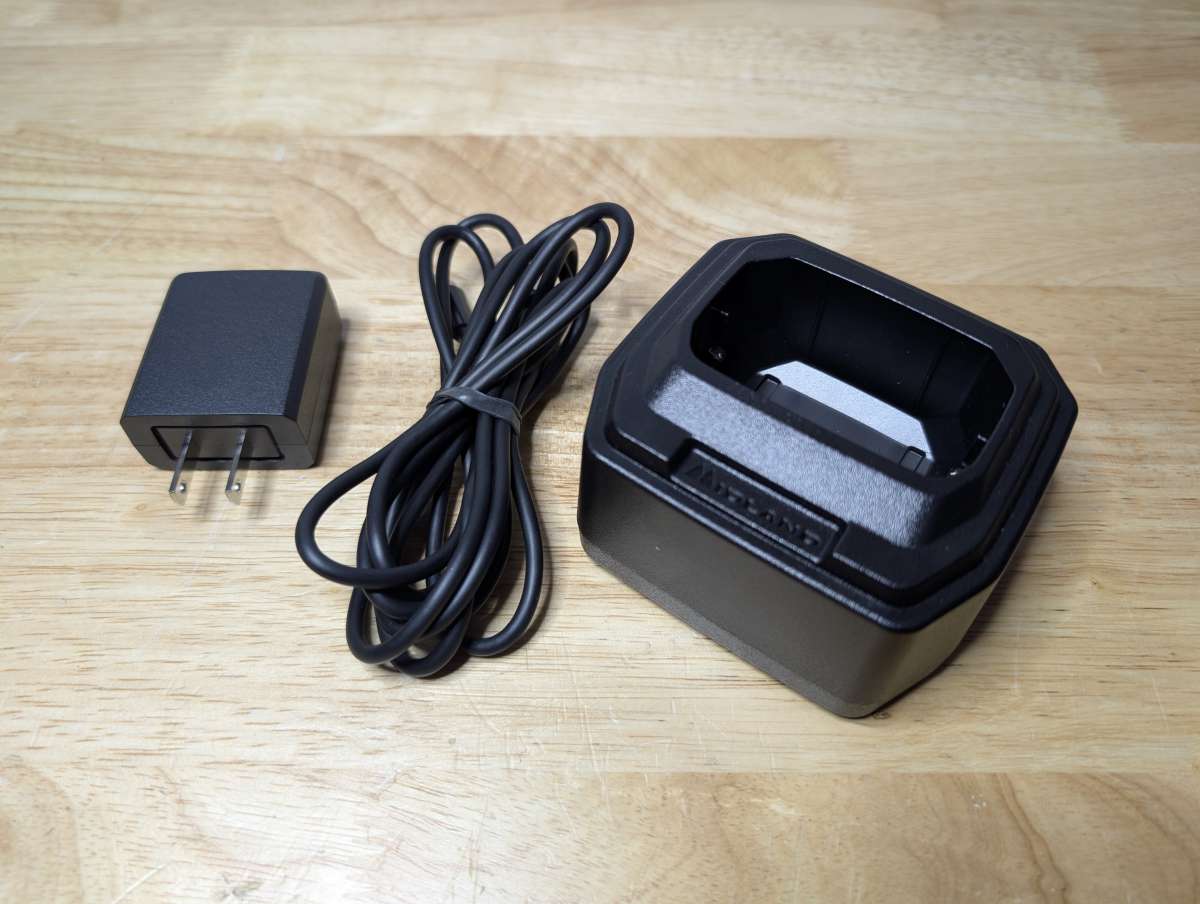
The desktop charger includes a USB power block and a USB-C cable. The battery can be charged while the radio is either on or off, though it takes longer to charge when the radio is on. The GXT67 internal battery is rated to last for 16 hours of use, up to 4 days in standby, and has a 4-hour rapid charge time.
My least favorite part of the GXT67 is that the battery compartment is factory-sealed to keep it waterproof, making the battery non-replaceable. The expectation is that the battery will last for the radio’s “serviceable life,” which Midland says is “several years.”
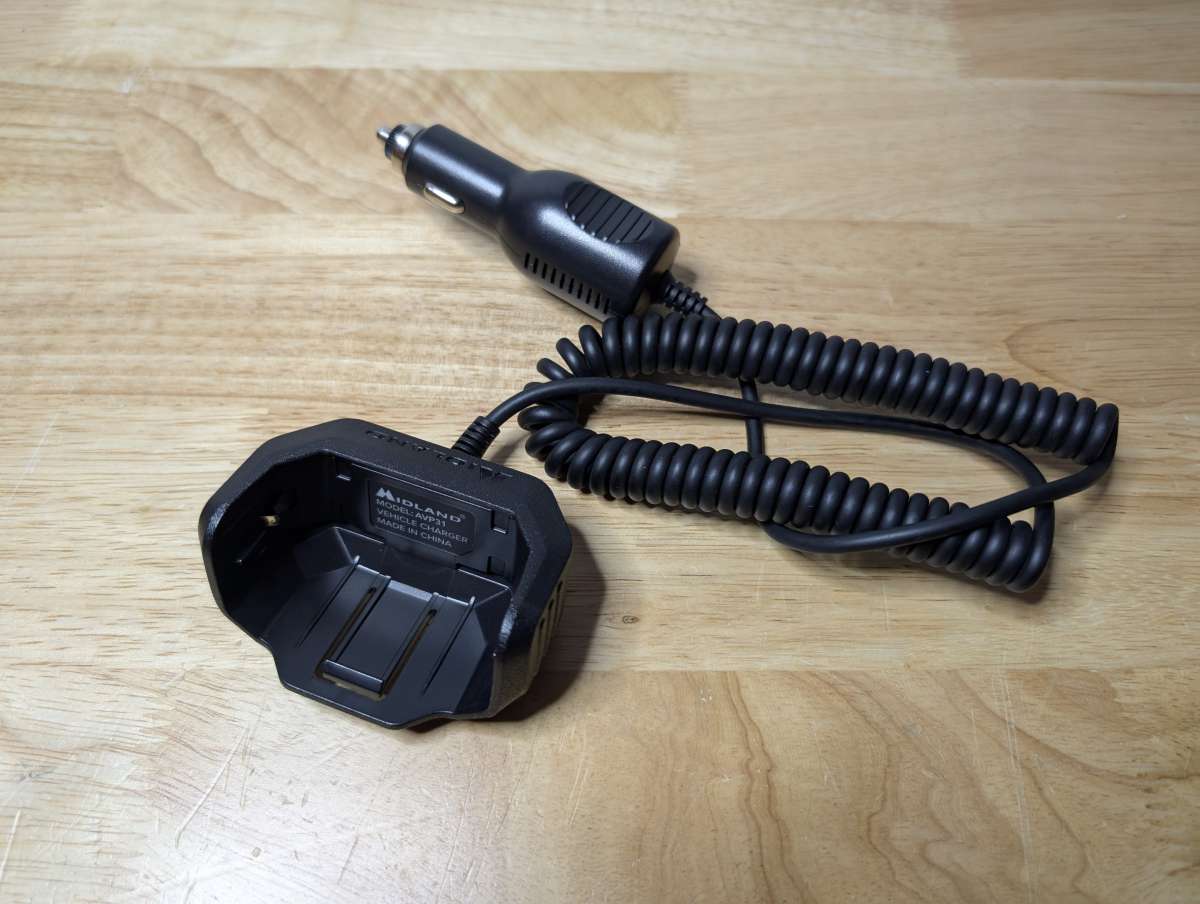
The car charger has a small mountable dock for the GXT67 Pro to sit in and is connected to a coiled power wire with a standard car 12V DC plug.
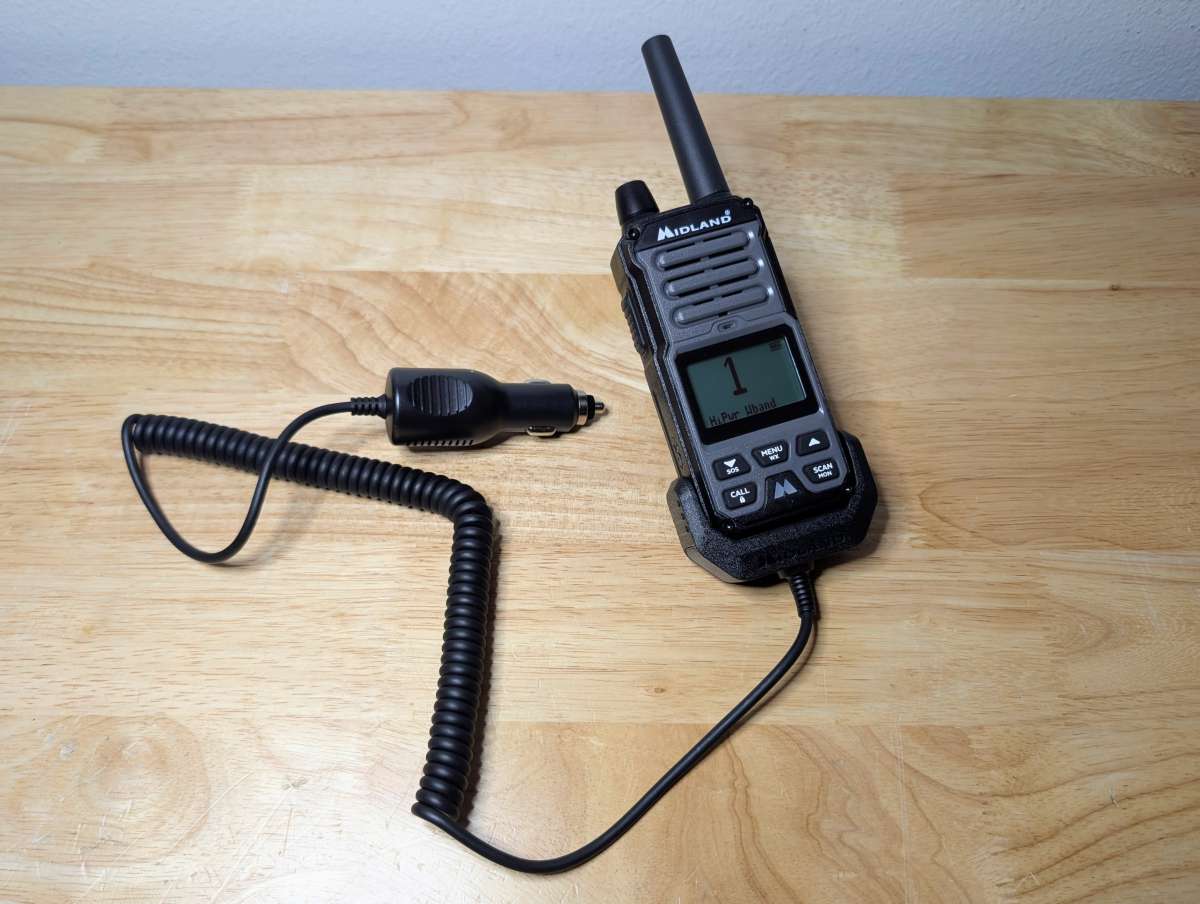
Assembly, Installation, Setup
Setting up the Midland GXT67 Pro is straightforward, even for those new to using GMRS radios. First, start by charging the rechargeable battery using the desktop or car charger. It’s advisable to charge the GXT67 Pro fully before the first use to ensure maximum battery life.
After the battery is charged, it’s really just a matter of changing the settings of the radio to your liking. I shut off the menu beep and changed a few of the color settings for the screen.
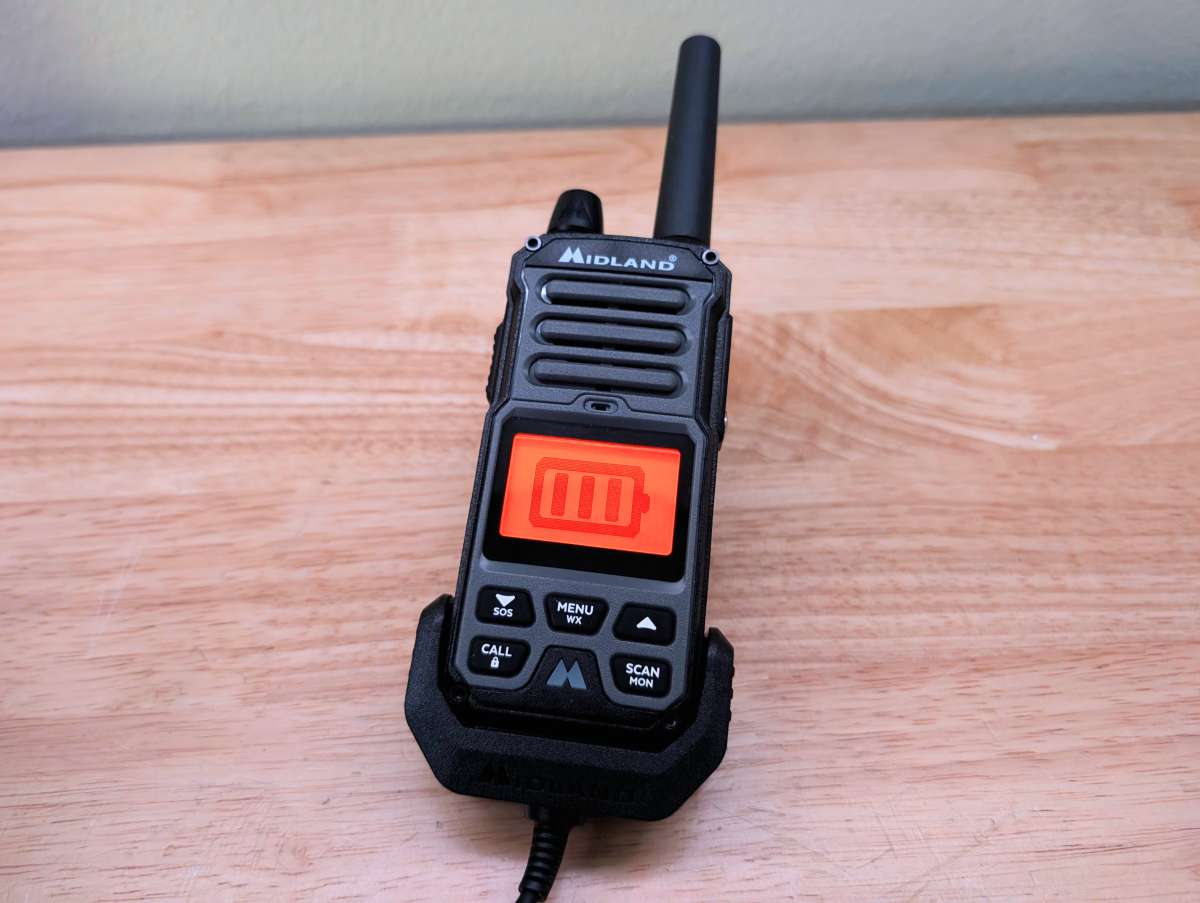
Performance
Thanks to the simplified design and controls, the GXT67 is an absolute joy to use. The menus are clearly labeled, as are the buttons, severely cutting down on confusion during use. The 5-watt power output provided a strong and clear signal, even in areas with challenging terrain. The GXT67 can easily reach up to 5 miles as long as the terrain is clear and flat. In densely wooded areas or urban environments with buildings, the range is drastically reduced, but it still maintains clarity. The battery provided power for a full day of use, connecting with my Midland MXT500 easily over varying distances.
The GXT67 has 8 repeater-capable GMRS channels as well which can further expand its reach. Repeaters are electronic devices that amplify and retransmit signals, allowing them to travel farther. Using a radio repeater can extend the range of the GXT67 Pro significantly and improve the clarity of two-way radio transmission.
If you have more than two people using radios in your group, you can engage the GXT67’s group mode and set up groups of radio users so that you can do a group call alert to only one group or all groups with the same group code.
The GXT67 Pro also has a NOAA Weather Alert Radio built in and I found myself going back to it frequently to check the weather for our surroundings. You can listen for current weather conditions or just set it to automatically alert you to impending severe weather events or other civil emergencies.
Overall, I am really impressed with the performance of the GXT67 Pro and all of its features, except for the non-replaceable battery and antenna.
Final thoughts
The Midland GXT67 Pro GMRS 5-Watt two-way radio exceeded all of my expectations and is a great addition to my overlanding gear. Coupled with my Midland MXT500 MicroMobile, the GXT67 Pro makes communicating when out in the wild easy and lots of fun. The GXT67 even works with my collection of Baofeng radios, which means everyone at camp can join the conversation. The simplified design of the GXT67 makes it a breeze for new users, but the inability to replace the battery or antenna has me concerned about its longevity. Priced at $199.99, the GXT67 is much more expensive than similar radios, but the included car charger, charging dock, and carrying case make it worth the premium price.
What I like about the Midland GXT67 Pro GMRS 5-Watt two-way radio
- Plain English menus make it easy to navigate
- Simplified design is great for first time users
- Includes a table charger, car charger, and case
What needs to be improved?
- Battery is not removable or replaceable
- Antenna is not removable or replaceable
- More expensive than similar two-way radios
Price: $199.99
Where to buy: Midland and Amazon
Source: The sample of this product was provided for free by Midland. Midland did not have a final say on the review and did not preview the review before it was published.



Gadgeteer Comment Policy - Please read before commenting
I am a long time radio enthusiast and Extra Class Ham radio holder. Advertising this as a 50 mile radio is ludicrous. Without EXTREME circumstances and without repeaters, 1-2 miles in normal environments would be amazing.
Extra Class here.. Agree with you 100%. Put the time in and get a Ham Tech license and use a “real” radio.
Technician class here (N9MSN) but I haven’t used my license or a Ham radio in a very long time.
LOL… seems to be a requirement for reading The Gadgeteer!!
Extra Class here (W2KRP)
How complicated is FCC license and how much?